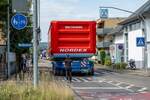News Release from WindEurope
Wind Industry Profile of
02/24/2023
Europe must boost the competitiveness of its wind supply chain
But the wind supply chain lacks the money to invest at the required scale. Europe’s 5 wind turbine manufacturers continue to operate at a loss.
Why is the wind supply chain struggling when EU wind targets are ambitious?
There are several reasons to this situation:
- Higher renewables targets don’t yet translate into wind turbine orders: the EU is building wind farms at half the rate it should be to meet the REPowerEU targets. Permitting bottlenecks remain the main problem: 80 GW of wind projects are stuck in permitting procedures, mostly onshore wind. For offshore wind, long permitting lead times mean that higher buildout only creates manufacturer revenues several years later.
- Commodity prices: higher steel and other commodity prices, higher shipping costs and supply chain bottlenecks have made all major components going into a wind turbine more expensive. The supply chain must absorb these additional costs because of the time-lag between a wind turbine order and its actual delivery.
- Poorly designed auctions: Government auctions for new wind farms are nearly all about price. This has driven a race to the bottom. Some countries even allow negative bidding, where developers must pay for the right to build a wind farm. This means extra costs that must be passed on to the supply chain (which is losing money) or consumers (who are struggling to pay power bills).
- Lack of level playing field with international competitors: today nearly all of Europe’s wind turbines are made in Europe. But Chinese manufacturers are now starting to beat us on cost and to win orders in Europe.
- Uncertainty on renewable revenues: poorly designed Governments interventions on electricity markets in 2022 rocked investor confidence and altered revenue flows for wind energy projects. Investments in wind energy fell last year with almost no new Final Investment Decision in offshore wind, and orders for new wind turbines were down 47% compared to 2021.
What should the EU do on wind energy industrial policy?
The European Commission will table new legislation for an EU’s Green Deal Industrial Plan this March. This will be key in reversing the troublesome trends of the wind supply chain. The Plan must provide a robust and meaningful answer to the US Inflation Reduction Act as clean energy industries are now debating where they should invest. And they need clear signal that it’s going to be Europe.
The EU Green Deal Industrial Plan will deliver if:
- It keeps a narrow and targeted scope on the key delivering technologies for climate neutrality, namely wind, solar, storage, electrolysers and heat pumps and their adjacent supply chains.
- It dedicates EU resources (funding and financing) to support immediate investments in the wind supply chain, alongside the more flexible approach to national tax credits, which also have an important role to play.
- It keeps funding and financing allocation rules simple so money can get to the supply chain asap. The investments in renewables are needed now so we can hit the 2030 objectives.
- It helps further accelerate permitting for wind energy projects. An additional impetus for National Governments to apply asap the EU emergency rules on permitting alongside the permitting simplification rules of the Renewable Energy Directive will help.
- It ensures auction volumes for wind energy are reliable and frontloaded because lead times are such that auctions only translate into order deliveries with some years’ delay. National Governments are mandated by the Renewable Energy Directive to at least 3 years’ visibility on auctions.
- It ensures EU State aid rules allow National Government to fully index support schemes granted in auctions to reflect possible increases in input prices.
- It guarantees EU State aid rules give full flexibility to National Governments to use non-price criteria in auctions to reward the added value that European manufacturers bring in terms of energy system integration, sustainability, European jobs and community engagement.
- It ensures National Governments avoid negative bidding where the industry pays for the ‘privilege’ of building a wind farm.
- Source:
- WindEurope
- Author:
- Press Office
- Link:
- windeurope.org/...
- Keywords:
- WindEurope, supply chain, Europe, competitiveness, investment, imnnovation, grid, production capacity, target, REPowerEU

























